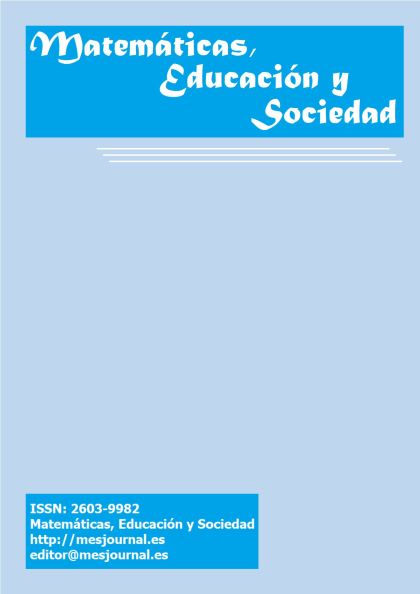Functions: conversions of registers in school textbooks
Main Article Content
Abstract
Functions are considered one of the most important topics in mathematics as well as the relationship of this science with other disciplines. The student's difficulty to relate the different semiotic registers that allow representing and working with functions is one of the most mentioned by Mathematics Education researchers. This paper analyzes the proposal for addressing the theme of four current school textbooks, focusing on describing the tasks presented around the registers of representation that they put into play and the cognitive demand that their resolution requires from the student body. The analyzed texts present tasks with a predominantly second level cognitive demand, that is, they require students to establish relationships between different registers in the same task for its resolution. However, the authors prioritize conversion tasks between verbal to graphic register and vice versa. The other conversions are very little demanded in the resolution of the tasks.
Downloads
Article Details
This work is licensed under a Creative Common License (CC BY 3.0 ES)
References
Altman, S., Arnejo, M., Comparatore, C., y Kurzrok, L. (Coord.) (2018). Matemática 1. Tinta fresca.
Artigue, M. (1998). Enseñanza y Aprendizaje del análisis elemental: ¿qué se puede aprender de las investigaciones didácticas y los cambios curriculares? Relime, 1(1), 40-55.
Berman, A., Dacunti, D., Pérez, M., y Veltri, A. (2015). Matemática II. Santillana.
Borsani, V., Lamela, C., Murúa, R., y Sessa, C. (Coord.) (2018). Hacer Matemática 1 / 2. Estrada.
Calvo, C., Deulofeu, J., Jareño, J., y Morera, L. (2016). Aprender a enseñar matemáticas en la educación secundaria obligatoria. Síntesis.
Cantoral, R., Montiel, G., y Reyes-Gasperini, D. (2015). Análisis del discurso Matemático Escolar en los libros de texto, una mirada desde la Teoría Socioepistemológica. Avances de Investigación en Educación Matemática, 8, 9 – 28.
D´Amore, B. (2017). Interacciones constructivistas en el aprendizaje de los conceptos matemáticos: conceptualización, registros de representaciones semióticas y noética. En B. D´Amore y L. Radford (Eds.), Enseñanza y aprendizaje de las matemáticas: problemas semióticos, epistemológicos y prácticos (pp. 69 - 95). UDF Editorial.
De Simone, I. y Turner, M. (2018). Matemática. Introducción al pensamiento lógico y creativo. AZ.
Dreyfus, T. (2000). La demostración como contenido a lo largo del curriculum. En N. Gorgorió, A. Deulofeu y A. Bishop (Eds.), Matemáticas y educación. Retos y cambios desde una perspectiva internacional (pp. 125-136). Graó.
Duval, R. (1999). Semiosis y pensamiento humano: Registros semióticos y aprendizajes intelectuales. (Traducción de Miryam Vega). Universidad del Valle.
Duval, R. (2006). Un tema crucial en la educación matemática: La habilidad para cambiar el registro de representación. La Gaceta de la Real Sociedad Matemática Española, 9(1), 143-168.
Duval, R. (2016). Un análisis cognitivo de problemas de comprensión en el aprendizaje de las matemáticas. En R. Duval, y A. Sáenz-Ludlow (Eds.), Comprensión y aprendizaje en matemáticas: perspectivas semióticas seleccionadas (pp. 61-94). Énfasis.
Duval R. (2017). Understanding the Mathematical Way of Thinking – The Registrers of Semiotic Representations. Springer.
Font, V. (2011). Funciones. En J. Goñi, J. Barragués, M. Callejo, J. Fernández, S. Fernández, V. Font, y G. Torregrosa, Matemáticas, complementos de formación disciplinar (pp. 145-185). Graó.
Godino, J., y Font, V. (2003). Razonamiento Algebraico y su Didáctica para Maestros. Universidad de Granada.
Godino, J. D., Wihelmi, M. R., Blanco, T. F., Contreras, A., y Giacomone, B. (2016). Análisis de la actividad matemática mediante dos herramientas teóricas: Registros de representación semiótica y configuración ontosemiótica. Avances de Investigación en Educación Matemática, 10, 91-110.
Hitt, F. (2003). El carácter funcional de las representaciones. Annales de didactique et de sciencies cognitives, 8, 255-271.
Hitt, F. (2014). Nuevas tendencias en la enseñanza del cálculo: la derivada en ambientes TICE. Revista AMIUTEM, 2(2), 1-19.
Mcmillan, J.H. y Schmacher, S. (2005). Investigación educativa. (5° edición). Pearson Addison Wesley.
OCDE (2003). Programme for International Student Assessment. Ministerio de Educación y Ciencia (MEC) - Instituto Nacional de Evaluación y Calidad del Sistema Educativo (INECSE) (2005) PISA 2003. Pruebas de matemáticas y de Solución de Problemas. http://pisaparacentroseducativos.es/pdf/Items%20liberados%20Matem%C3%A1ticas.pdf
Penalva, M., y Llenares, S. (2011). Capítulo 2: Tareas matemáticas en la educación secundaria. En J. Goñi (Ed.), Didáctica de las Matemáticas (pp. 27-51). Graó.
Prada-Núñez, R. P., Hernández-Suárez, C. A., y Contreras, L. A. J. (2017). Representación semiótica de la noción de función: concepciones de los estudiantes que transitan del Colegio a la Universidad. Panorama, 11(20), 34-44.
Ruiz-Higueras, L. (1994). Concepciones de los alumnos de secundaria sobre la noción de función. Análisis epistemológico y Didáctico. [Tesis Doctoral. Universidad de Granada]. http://enfoqueontosemiotico.ugr.es/tesis/Tesis_LRuiz-Higueras.pdf
Spivak, J. (1996). Cálculo infinitesimal. (2da. Ed). Reverté.
Soto, M., Herrera, C., y Pereyra, N. (2019). Coordinación de Registros de Representación en el Aprendizaje de la Función Lineal. Unión: revista iberoamericana de educación matemática, 55, 71-84.

